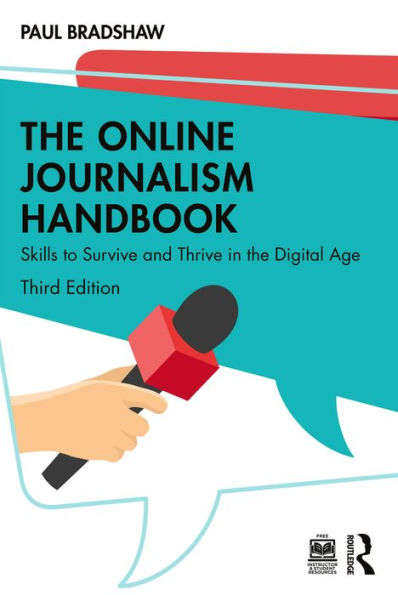The Online Journalism Handbook offers a comprehensive guide to the ever-evolving world of digital journalism, showcasing the multiple possibilities in researching, writing, and storytelling provided by new technologies.
In this new edition, Paul Bradshaw presents an engaging mix of technological expertise with real-world practical guidance to illustrate how those training and working as journalists can improve the development, presentation, and global reach of their stories through webbased technologies.
Thoroughly revised and updated, this third edition features:
- A new chapter dedicated to writing for email and chat, with updated case studies
- New sections covering online abuse, news avoidance, and trust
- Updated coverage of accessibility, inclusivity, and diversity in sourcing, writing for social media, and audio and video
- New formats, including social audio, audiograms, Twitter threads, the “Stories” format, charticles, and “scrollytelling”
- Expanded international examples throughout
The Online Journalism Handbook is an essential guide for all journalism students and professional journalists and will also be of interest to digital media practitioners.
The companion website for this book further enhances student knowledge through regularly updated case studies, real-time development reports, and in-depth discussion pieces from cutting-edge sources.
The Online Journalism Handbook offers a comprehensive guide to the ever-evolving world of digital journalism, showcasing the multiple possibilities in researching, writing, and storytelling provided by new technologies.
In this new edition, Paul Bradshaw presents an engaging mix of technological expertise with real-world practical guidance to illustrate how those training and working as journalists can improve the development, presentation, and global reach of their stories through webbased technologies.
Thoroughly revised and updated, this third edition features:
- A new chapter dedicated to writing for email and chat, with updated case studies
- New sections covering online abuse, news avoidance, and trust
- Updated coverage of accessibility, inclusivity, and diversity in sourcing, writing for social media, and audio and video
- New formats, including social audio, audiograms, Twitter threads, the “Stories” format, charticles, and “scrollytelling”
- Expanded international examples throughout
The Online Journalism Handbook is an essential guide for all journalism students and professional journalists and will also be of interest to digital media practitioners.
The companion website for this book further enhances student knowledge through regularly updated case studies, real-time development reports, and in-depth discussion pieces from cutting-edge sources.

The Online Journalism Handbook: Skills to Survive and Thrive in the Digital Age
362
The Online Journalism Handbook: Skills to Survive and Thrive in the Digital Age
362eBook
Related collections and offers

Product Details
| ISBN-13: | 9781000896756 |
|---|---|
| Publisher: | Taylor & Francis |
| Publication date: | 07/28/2023 |
| Sold by: | Barnes & Noble |
| Format: | eBook |
| Pages: | 362 |
| File size: | 2 MB |
